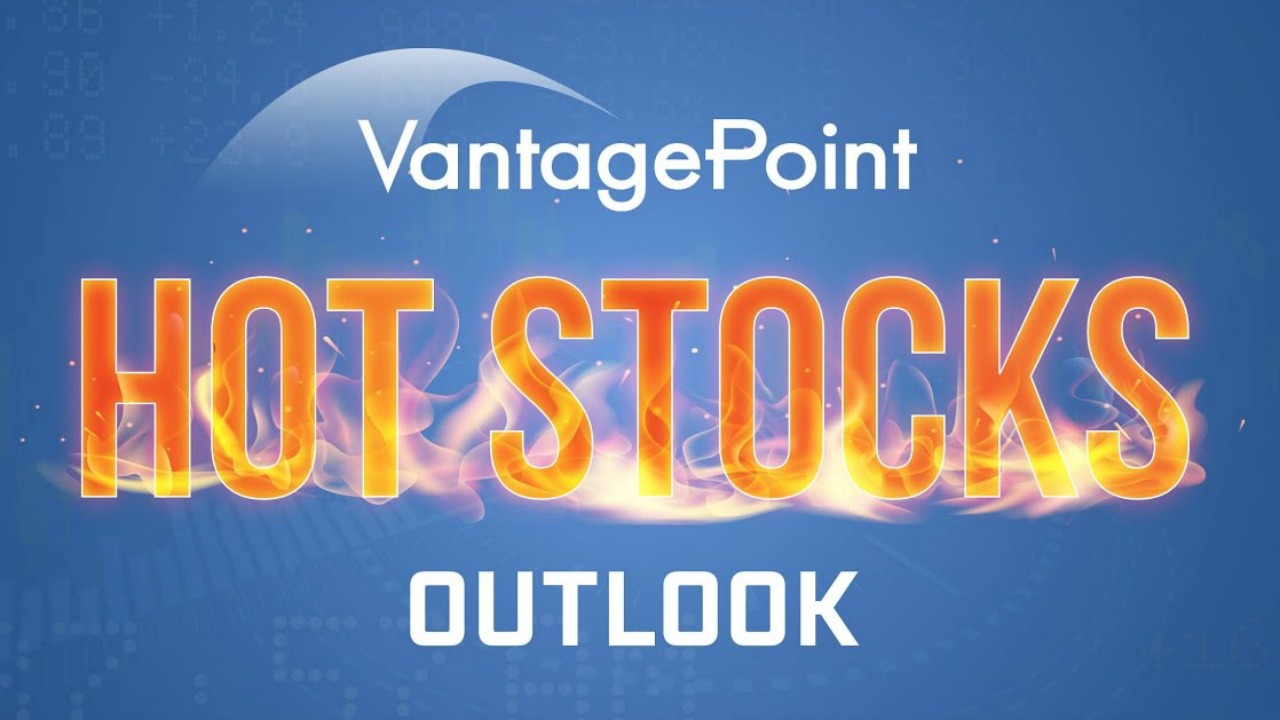Weekly Stock Study – Molson Coors (TAP)
This week’s stock analysis is Molson Coors (TAP).
The Molson Coors Beverage Company, commonly known as Molson Coors (TAP), is a multinational drink and brewing company headquartered in Chicago in the United States. Molson Coors was formed in 2005 through the merger of Molson of Canada, and Coors of the United States. In 2016, Molson Coors acquired the full global brand portfolio of Miller Brewing Company for approximately US$12 billion. The agreement made Molson Coors the world’s third largest brewer at the time.
Molson Coors is a publicly traded company on both the New York Stock Exchange and Toronto Stock Exchange. It has a market cap of $12.74 billion, and trades average volume of 2.6 million shares per day.
10 Wall Street analysts have issued ratings and price targets for Molson Coors Beverage in the last 12 months. Their average twelve-month price target is $51.18, predicting that the stock has a possible downside of 12.73%. The high price target for TAP is $62.00 and the low-price target for TAP is $40.00. There are currently 2 sell ratings, 5 hold ratings, and 3 buy ratings for the stock, resulting in a consensus rating of “Hold.”
Let’s start our analysis with the commonsense metrics. Over the last 52 weeks, Molson Coors (TAP) has traded as high as $58.94 and as low as $32.11. This tells us that the annual trading range is $26.83. The average weekly trading range is .515 cents. When we study the charts, we start by analyzing where the market is in relationship to its 52-week high and low. Experience tells us that stocks which successfully breach their 52-week highs on strong momentum tend to move higher, and vice-versa. During the start of the pandemic $TAP fell 39% in a matter of weeks. It proceeded to make a 52-week low at $32.11 and has since moved higher and is currently testing its 2-year high mark.
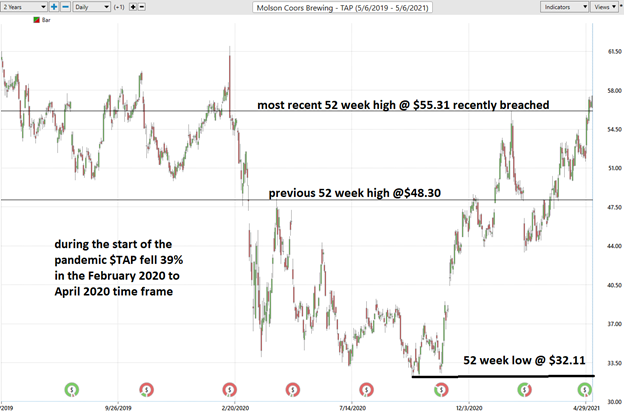
The fundamental outlook for $TAP is rather negative. The beer business was crushed by COVID-19, despite the fact liquor store sales seemed to surge in the early days of the pandemic. Beer consumption has declined as it becomes harder to physically meet with friends at a local pub or restaurant.
The last decade has been defined by regional breweries, microbreweries, and taprooms eating into established brands market share. Molson Coors and other large brewing brands have been steadily losing market share, losing distribution in the market.
Against that backdrop, $TAP has been facing falling revenue, declining margins, and falling profitability for several years. Tragically in 2020, the company actually lost revenue.
While we do not create a valuation based upon these fundamental factors, we study them to understand the financial landscape that the company is operating under. It is not uncommon for a stock with negative fundamentals create positive explosive movement. This is because it is largely unexpected, and the company is often addressing the very factors which led to the negative fundamental outlook.
The big themes facing $TAP are that beer consumption is declining, craft brewers are taking market share from Big Beer, and there’s little room to cut costs or raise prices after years of consolidation in the beer industry. The pandemic has shut down bars and restaurants which is a primary source of demand, leading to more revenue losses and even a net loss for Molson Coors.
As the country recovers from the pandemic $TAP should benefit but it will be an uphill battle fighting the bleak longer term fundamental picture. The core business is being squeezed from all sides. Big brand name beer has seen its best days. Since the beginning of the year, Molson Coors (TAP) has outperformed the broader market by a huge margin. It is up 22% while the broader market is up on 12% on the year.
The Vantagepoint A.I. Analysis
Whenever we look at a stock forecast, we always are comparing what the stock has done, to the artificial intelligence, which is computing its forecast based upon a proprietary intermarket analysis of the most closely correlated assets as well as a neural network computation.
The key to the Vantagepoint analysis is the predictive blue line. The slope and general direction of the blue line determines the medium forecast for the market. The Vantagepoint Software has three separate modules which create a forecast for a Power Trader. They are the predictive blue line, the Neural Net, and the Intermarket Analysis.
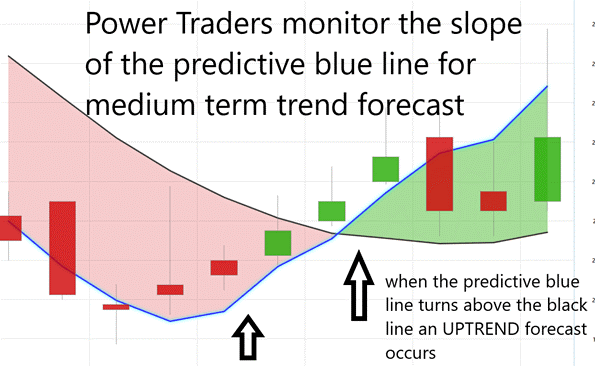
The predictive blue line also acts as value zone where in uptrends traders try to purchase the asset at or below the blue line. Power traders use the predictive blue line in helping to determine both the value zone as well as the trend direction.
The black line that you see that is a regular simple 10 period moving average. A very common technical indicator. It’s a good measure to go ahead and smooth out the price data and it gives us an indication of where market prices have been over a given period of time. But obviously as traders we really need to understand is where our market price is moving going forward.
So, what we want to do is compare that black line value on the chart to the predictive blue line, which is VantagePoint’s predictive indicator. VantagePoint utilizes its technology to perform what’s called intermarket analysis. That means there’s detectable relationships as far as those neural networks are concerned that affect and drive the future price of $TAP. That could me markets like the S&P 500 or the Russell 2000 or the NASDAQ. Or things like global currencies or global interest rates, or futures and commodity markets.
To understand and appreciate how powerful this indicator is, let me show it to you without any of the daily price bars on the chart. The slope of the predictive blue line determines the short-term trend. On the following graphic, monitor that you would want to buy when the slope of the blue line is going up. When the slope of the blue line is going sideways you would be anticipating sideways prices. Likewise, when the slope of the blue line is going down you would be anticipating lower prices.
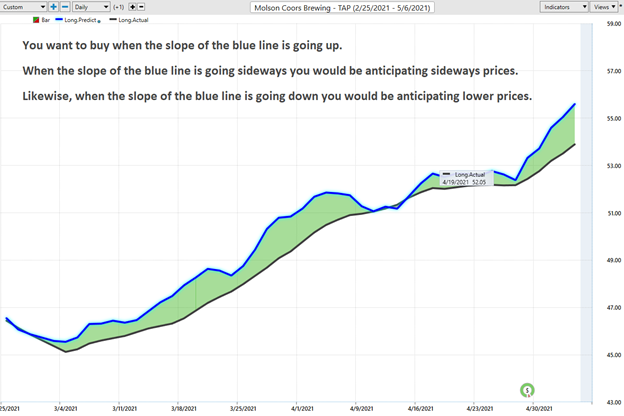
Observe “when” the SLOPE of the predictive blue line started moving higher and how price behaved.
Here is the same chart with the accompanying daily price bars. As you look through this chart study how Power Traders always try to look for trade opportunities at or below the predictive blue line, as that is considered to be the IDEAL VALUE zone for traders.
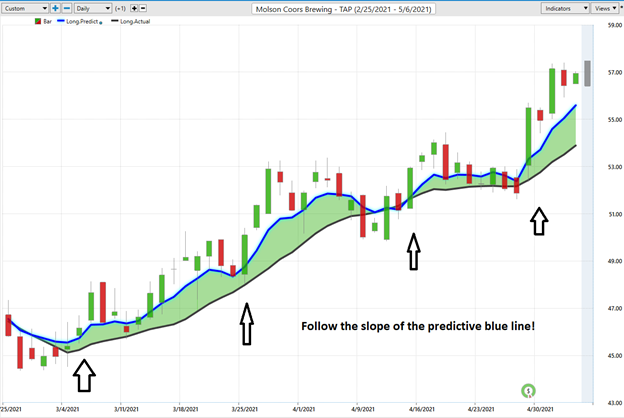
At the bottom of the chart is the Neural Network Indicator which predicts future short-term strength and/or weakness in the market. When the Neural Net Indicator is green it communicates strength. When the Neural Net is red it is forecasting short term weakness in the market.
We advocate that Power Traders cross reference the chart with the predictive blue line and neural network indicator to create optimal entry and exit points.
Power Traders are always looking to apply both the neural network and A.I. to the markets to find statistically sound trading opportunities.
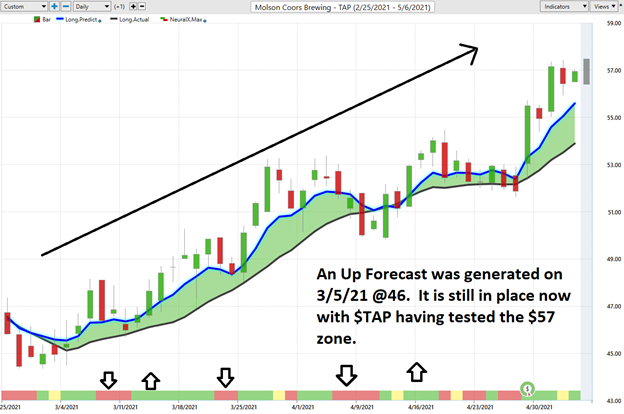
Power Traders have had multiple opportunities to exploit nice gains in $TAP by monitoring the artificial intelligence forecasts.
Fine Tuning Entries and Exits
One of the powerful features in the Vantagepoint A.I. Software which Power Traders use on a daily basis is the Price Range prediction forecast.
This forecast is what permits Power Traders to truly fine tune their entries and exits into the market.
At 6:30pm after the market close the software updates and all the price predictions change based upon what the machine learning, A.I., neural networks, and intermarket analysis anticipate moving forward.
Here is the price chart of $TAP during the most recent runup featuring the Daily Price Range forecast with the NeuralNet Index at the bottom of the chart. Day traders who are looking for short term swings in the markets focus on the daily price ranges to place their entry and exit orders.
By utilizing these tools simultaneously Power Traders can locate precision entries and exits with solid probabilities of success and are capable of exploiting short-term swing trading opportunities.
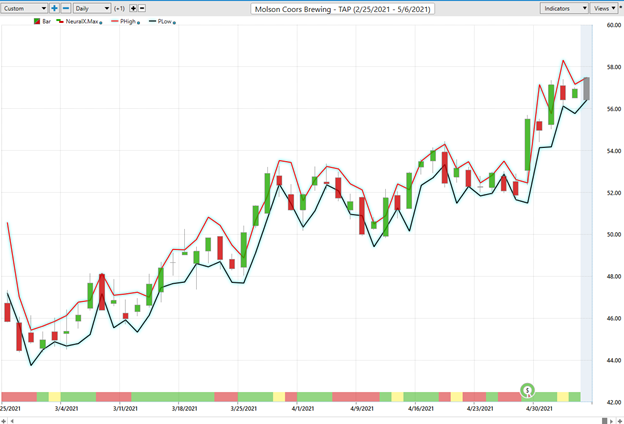
Power Traders use a price level below the predictive low price to place their protective sell stops in the market in case a sudden reversal was to occur.
Traders use these VantagePoint tools either independently or together to find great trading opportunities. When we find a strong powerful trend in a stock, often times we simply look at the daily price range forecast to find our short term entry and exit points. It is very easy. Very powerful. And often can revolutionize the way you trade.
Intermarket Analysis of Molson Coors (TAP)
We live in a global marketplace. Everything is interconnected. The billion dollar question for traders is always what are the key drivers of price for the underlying asset that I am trading?
What makes Vantagepoint unique and distinct when compared to all other analytical tools is its patented and proprietary intermarket analysis.
Intermarket analysis is a method of analyzing markets by examining the correlations between different asset classes. In other words, what happens in one market could, and probably does, affect other markets, so a study of the relationship(s) is often very helpful to a trader. We suspect that what has been driving Molson Coors (TAP) higher in recent weeks has been the country re-opening slowly after the pandemic. This is an opinion, but it becomes a very powerful thought exercise to cross reference that opinion against the key drivers in the following graphic. There is great value to be had in studying and understanding the key drivers of $TAP price action.
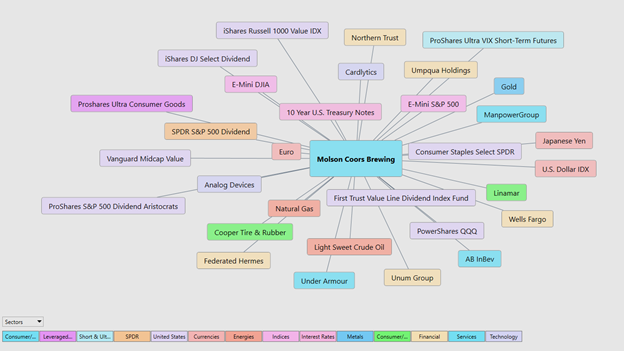
Small changes in Interest rates, Crude Oil Prices, and the Volatility of the dollar amongst thousands of other variables affect the decisions companies must make to survive in these very challenging times. Trying to determine what these factors are is one of the huge problems facing investors and traders.
There is great value to be had in studying and understanding the key drivers of $TAP price action. universe and the most statistically correlated assets. These factors are all displayed from a standpoint of statistical correlations which show the strongest interconnectedness of prices.
Instead of looking at financial markets or asset classes on an individual basis, intermarket analysis looks at several strongly correlated markets, or asset classes, such as other stocks, currencies, ETF’s, and commodities. This type of analysis expands on simply looking at each individual market or asset in isolation by also looking at other markets or assets that have a strong relationship to the market or asset being considered. The Vantagepoint software analyzes the top 31 drivers of an assets price. This analysis will often show ETF’s which are big owners of the underlying asset, but it will also uncover other markets which are statistically correlated to the trend you are analyzing. Traders often find other blossoming opportunities when engaging in Intermarket Analysis.
Our Suggestion on Molson Coors (TAP)
$TAP is fairly valued but the trend is and has been up for the last two months. Power Traders who got long early may want to begin taking profits or scaling back exposure. The most optimistic Wall Street Analysts rating says they think their highest target is $62 per share. We think the longer-term upside gains could be limited in $TAP.
We approach our analysis not from a fundamental valuation perspective but from a pure trader’s viewpoint. Currently, the stock appears fairly valued fundamentally. We do think it can go higher but because of the fundamental headwinds, we think gains will find a good deal of resistance. Overall, we think there are better opportunities and better risk/reward ratios in other markets. We have had it on our radar many times over the past year and will continue to monitor it for solid trading opportunities.
Our suggestion – Follow the A.I. trend analysis and practice good money management on all of your trades. $TAP has proven over and over again to be a good candidate for short term swing trading opportunities.
Remember, It’s Not Magic.
It’s Machine Learning.
Disclaimer: THERE IS A HIGH DEGREE OF RISK INVOLVED IN TRADING. IT IS NOT PRUDENT OR ADVISABLE TO MAKE TRADING DECISIONS THAT ARE BEYOND YOUR FINANCIAL MEANS OR INVOLVE TRADING CAPITAL THAT YOU ARE NOT WILLING AND CAPABLE OF LOSING.
VANTAGEPOINT’S MARKETING CAMPAIGNS, OF ANY KIND, DO NOT CONSTITUTE TRADING ADVICE OR AN ENDORSEMENT OR RECOMMENDATION BY VANTAGEPOINT AI OR ANY ASSOCIATED AFFILIATES OF ANY TRADING METHODS, PROGRAMS, SYSTEMS OR ROUTINES. VANTAGEPOINT’S PERSONNEL ARE NOT LICENSED BROKERS OR ADVISORS AND DO NOT OFFER TRADING ADVICE.









